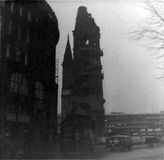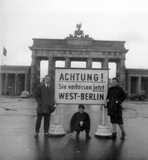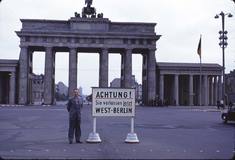Berlin 1959 photos
 My family arrived in Frankfurt, Germany, on February 16, 1959, and for some
reason my father took us to Berlin for a few days just a week or two later.
This was two and a half years before the Wall went up. The weather was wet
and foggy most of the time. All the black-and-white photos in this gallery
were taken with my Brownie
Hawkeye box camera, all by me except for the ones I'm in (and the
Spandau one). The color ones were taken by my father (except the one he's
in), and were copied here from the Frankfurt
color photos gallery in March 2024, to bring all the Berlin photos
together, and with corrections and improvements from Victor Grossman
in Berlin.
My family arrived in Frankfurt, Germany, on February 16, 1959, and for some
reason my father took us to Berlin for a few days just a week or two later.
This was two and a half years before the Wall went up. The weather was wet
and foggy most of the time. All the black-and-white photos in this gallery
were taken with my Brownie
Hawkeye box camera, all by me except for the ones I'm in (and the
Spandau one). The color ones were taken by my father (except the one he's
in), and were copied here from the Frankfurt
color photos gallery in March 2024, to bring all the Berlin photos
together, and with corrections and improvements from Victor Grossman
in Berlin.
[ Berlin gallery 1961 ] [ Frankfurt chapter ] [ Family history index ]
▲
(Click on any photo to enter)
Like Germany itself, Berlin was divided into four sectors
of occupation: American, British, French, and Soviet. Berlin was inside
the Soviet sector (East Germany, the German Democratic Republic), and itself
divided into the same four occupation sectors. In 1959, you could walk
right through the Brandenburg gate to East Berlin. No checkpoints, no
guards. Subways (U‑Bahn and S‑Bahn) ran back and forth too.
If you want to see some good footage from those pre-Wall times, I highly
recommend these excellent films:
- Die Die Mörder sind unter uns (1946) starring Hildegard Knef and Ernst Wilhelm Borchert: the very first post-war film in all of Germany, the first Trümmerfilm (rubble film), and a product of the East German Deutsche Film-Aktiengesellschaft (DEFA).
- Ehe im Schatten (DEFA, 1947), not exactly a rubble film but the first German film to confront Germans with their persecution of the Jews and the atrocities conducted during World War II, and the only film to be released simultaneously in all sectors of occupied Berlin [Wikipedia].
- The Big Lift (1950). An extraordinary film, shot entirely on location in the ruins of West and East Berlin, about the Berlin Airlift, filmed only 8 years before I flew into Berlin Tempelhof on a DC-4 airliner, civilian counterpart to the C-54 cargo plane used in the airlift, at age 14 when I took these pictures.
- Billy Wilder's One, Two, Three, a Cold War comedy filmed in 1961 (I was still in Frankfurt when the Wall went up two years after I took these pictures). Wilder was a filmkaker in Berlin when the Nazis came to power and in 1934 he fled to Paris and then Hollywood (read more about him HERE).
- Berlin Express (about 1948), which, despite its name, was filmed in postwar Frankfurt, starring Merle Oberon and Robert Ryan.
- Decision Before Dawn (1950), about the final months of the war, filmed largely in the ruins of Würzburg, Mannheim, and Nürnberg, a joint US-German-Austrian production. It's amazing how much these places were rebuilt between 1950 and 1959-61, when I saw them.
- The Third Man with Orson Welles (1949). Filmed in Vienna (Wien), which was also divided into sectors of occupation, like Austria itself and exactly like Germany, with the difference that Vienna had five sectors: the four occupying powers and an international sector.
The Kaiser Wilhelm church ruin was preserved as a reminder of the consequences of war. The Reichstag (parliament building) had its insides burned out by Nazis in 1933 and then blamed on the Communists as a pretext for suspending civil rights and due process. The Soviet War Memorial commemorates the 25+ million people of the Soviet Union who died in the German invasion. It was guarded by a small contingent of Red Army soldiers, who marched in solemn slow motion around it. 2500 Soviet troops are buried here. CLICK HERE for a recent large color photo of the memorial. It's still there, but no more Red Army.
- Reference:
-
Berlin
Mitte und die Welt – wie sie einmal war 1914-1989,
P.J. Ortmann, published by the author (2009) (has one of my photos in it). - Also see:
-
Berlin 1961-62
Gallery (contributed by Robert C. Paul).
- Offsite links:
-
- Soviet War Memorial (Tiergargen)
- Soviet War Memorial (Treptow) - extremely moving, far more beautiful and certainly less martial than the Tiergarten memorial.
- Auferstanden aus Ruinen (Arisen from the Rubble): the anthem of the German Democratic Republic, probably the most beautiful, touching, and nostalgic of all national anthems.
- Berlin 1945 in color (Youtube, 7 minutes)
| Created by C-Kermit Photogallery 3.15 March 6, 2024 |




















